2014 年 4 月全国高等教育自学考试英语国家概况真题
课程代码:00522
请考生按规定用笔将所有试题的答案涂、写在答题纸上。
选择题部分
注意事项:
1. 答题前,考生务必将自己的考试课程名称、姓名、准考证号用黑色字迹的签字笔或
钢笔填写在答题纸规定的位置上。
2. 每小题选出答案后,用 2B 铅笔把答题纸上对应题目的答案标号涂黑。如需改动,用
橡皮擦干净后,再选涂其他答案标号。不能答在试题卷上。
I.MULTIPLE CHOICE
Read the following unfinished statements or questions carefully. For each
unfinished statement or question, four suggested answers marked A, B,C and D are
given. Choose the one that you think best completes the statement or answers the
question, Blacken the letter of the answer you have chosen in the corresponding space
on the answer sheet. (50 points,1 point for each)
1.The official name of the U.K. is ______.
A. England
B.Great Britain
C.the British Isles
D.the United Kingdom of Great Britain and Northern Ireland
2. ______ was the Roman general who invaded Britain for the first time in 55
BC.
A. Claudius B. Agricola
C. Augustus D. Julius Caesar
3.Among the following groups of people, the ______ came to Britain first.
A. Jutes B. Angles
�
C.Saxons D. Normans
4. The English people got their name from the Angles who came from ______.
A. France B. Norway
C. Denmark D. Germany
5. According to the feudal system in England, ______ owned all the land
personally.
A. the king B. the serfs
C. the knights and freemen D. the barons
6. The Magna Carta was a statement of the feudal and legal relationship between
______ .
A. the crown and the barons
B. the king and the parliament
C. the aristocrats and the middle class
D. the monarch and the working people
7. ______ in the 14th century was the modern name given to the deadly bubonic
plague, an epidemic disease spread by rat fleas.
A. Bird Flu B. Black Death
C. Yellow Fever D. Scarlet Fever
8. The English Civil War in the 17th century is also called the ______.
A. Puritan Revolution B. English Reformation
C. English Renaissance D. Industrial Revolution
9. The Wars of the Roses were fought between ______ .
A. the House of Lancaster and the House of York
�
B. the House of Lancaster and the House of Kent
C. the House of Winchester and the House of York
D. the House of Winchester and the House of Commons
10. ______ was generally regarded as the greatest writer in the English language.
A. Ben jonson B. Edmund Spencer
C. William Shakespeare D. Christopher Marlowe
11. During the late 18th and early 19th centuries the ______ system ended when
the Enclosure Acts were introduced.
A. “tenant” B. “feudal”
C. “open-field” D. “enclosed field”
12. As a result of the industrial revolution, Britain was by 1830 ______.
A. the workshop of the world B. an agricultural country
C. the workshop of auto industry D. the production center of grain
13. The First World War was fought ______.
A. at the end of the 19th century
B. at the end of the 20th century
C. at the beginning of the 19th century
D. at the beginning of the 20th century
14. In each member state of the Commonwealth of Nations, the Queen is represented
by ______.
A. a consul B. a general
C. an ambassador D. a Governor-General
15. Queen Elizabeth II, the current monarch of the U.K., came to the throne in
______.
�
A. 1950 B. 1952
C. 1954 D. 1956
16. The House of Commons is elected by universal adult suffrage and consists
of ______ Members of Parliament (MPs).
A. 551 B. 601
C. 651 D. 701
17. In the United Kingdom, central judicial responsibility lies with the
following EXCEPT ______.
A. Lord Chancellor B. Ministry of justice
C. the Home Secretary D. the Attorney General
18. ______ was one of the two established churches in Britain.
A. The Baptist Church B. The Methodist Church
C. The United Reformed Church D. The Church of Scotland
19. ______ University was the oldest British university dating from the 12th
century.
A. Oxford B. Glasgow
C. Edinburgh D. Cambridge
20. ______ is NOT a popular division of the British national newspapers based
on the differences in style and content.
A. Quality newspapers B. Popular newspapers
C. Spectator newspapers D. Mid-market newspapers
21. Supported by the ______ queen, Christopher Columbus discovered the New World
in the late 15th century.
A. Spanish B. Danish
C. Portuguese D. Norwegian
�
22. According to the textbook, there are ______ big cities with a population
over two million in the U.S.
A. 5 B. 1 5
C. 21 D. 30
23. The first ______ were brought to North America as slaves in 1619.
A. Blacks B. Hispanics
C. Indians D. Mexicans
24. In September, ______, the Treaty of Paris was signed and Britain recognized
the independence of the United States.
A. 1776 B. 1781
C. 1783 D. 1785
25. Black slavery disappeared in the north because of the following EXCEPT that
______.
A. the price of slaves was high
B. the North disliked black slaves
C. the North turned towards industry
D. the Africans could not stand cold winters in the North
26. ______ was NOT a feature in the growth of the American economy in the early
20th century.
A. A mushroom growth of cities
B. A slow development of steel industry
C. A rapid development of new technology
D. A growth of industrial and financial mergers
27. The ______ in the U.S. has been described by many historians as a period
of material success, spiritual frustration or confusion and purposelessness.
�
A. 1890s B. 1920s
C. 1930s D. 1950s
28. American policy towards the Soviet Union in the Second World War was centered
on the following considerations EXCEPT ______.
A. keeping the Soviet Union in the war
B.being watchful about Soviet expansive intention
C. getting the Soviet Union into the war against Japan
D. working out a strategy of alliance with the Soviet Union
29. The most important issue in ______ diplomacy after Pearl Harbor was the
formulation of a grand strategy of Europe first.
A. Soviet-American B. Franco-American
C. Sino-American D. Anglo-American
30. The idea of containment towards the Soviet Union was first brought up by
______ , a high-ranking official in the American embassy to Moscow.
A. Harry Truman B. George Kennan
C. George Marshall D. Franklin D. Roosevelt
31. Senator McCarthy was called a big liar in ______ in the U.S.
A. the Korean War B. the Civil Rights Movement
C. the Vietnam War D. the anti-Communist hysteria
32. The fast growth of American economy can be attributable to geographical
location, ______.
A. rich mineral resources, immigration and good quality of labor forces
B. military industries, enough labor supply and good quality of labor forces
C. rich mineral resources, enough labor supply and good quality of labor forces
�
D. rich mineral resources, enough labor supply and good quality of education
33. In the U.S., the ______ are government-run at the federal, state or/and local
levels.
A. ship-building, car-making and national defense
B. postal service, car-making and national defense
C. road system, ship-building and national defense
D. road system, postal service and national defense
34. In 1787,55 delegates from all the states met at ______ to revise the Articles
of Confederation.
A. Chicago B. New York
C. Philadelphia D. Washington D.C.
35. According to the text, despite its evident weakness the Articles of
Confederation had done one important thing: ______.
A. they formed a new nation
B. they set up a new government
C. they empowered Congress to tax
D. they provided for a national court system
36. The U.S. Constitution requires the ______ to be a natural-born American
citizen at least 35 years of age.
A. President B. Vice-president
C. House Speaker D. House Majority leader
37. The highest duty of the U.S. President is ______.
A. the amendment of bills
B. the execution of the law
�
C. the management of economy
D. the regulation of trade disputes
38. The three principal functions of higher education in the U.S. are ______.
A. teaching, research and publication
B. teaching, research and public service
C. teaching, research and voluntary service
D. teaching, research and vocational training
39. The song “Should old acquaintance be forgot and days of auld lang syne”
is usually sung on the eve of ______.
A. Thanksgiving Day B. Independence Day
C. Christmas D. New Year’s Day
40. It is commonly believed that death was one of the great themes of ______
poetry.
A. T. S. Eliot’s B. Emily Dickinson’s
C. Walt Whitman’s D. Langston Hughes’s
41. Ottawa, the capital city of Canada, is in the province of ______.
A. Alberta B. Quebec
C. Ontario D. Atlantic
42. While he failed to find the passage to Asia, ______ opened the interior of
Canada to French fur trades and later colonizers.
A. John Cabot B. Henry Hudson
C. Jacques Cartier D. Samuel de Champlain
43. In 1971, the Canadian government adopted a policy of multiculturalism and
encouraged its immigrants to maintain their particular ______ heritages since then.
A. cultural B. political
�

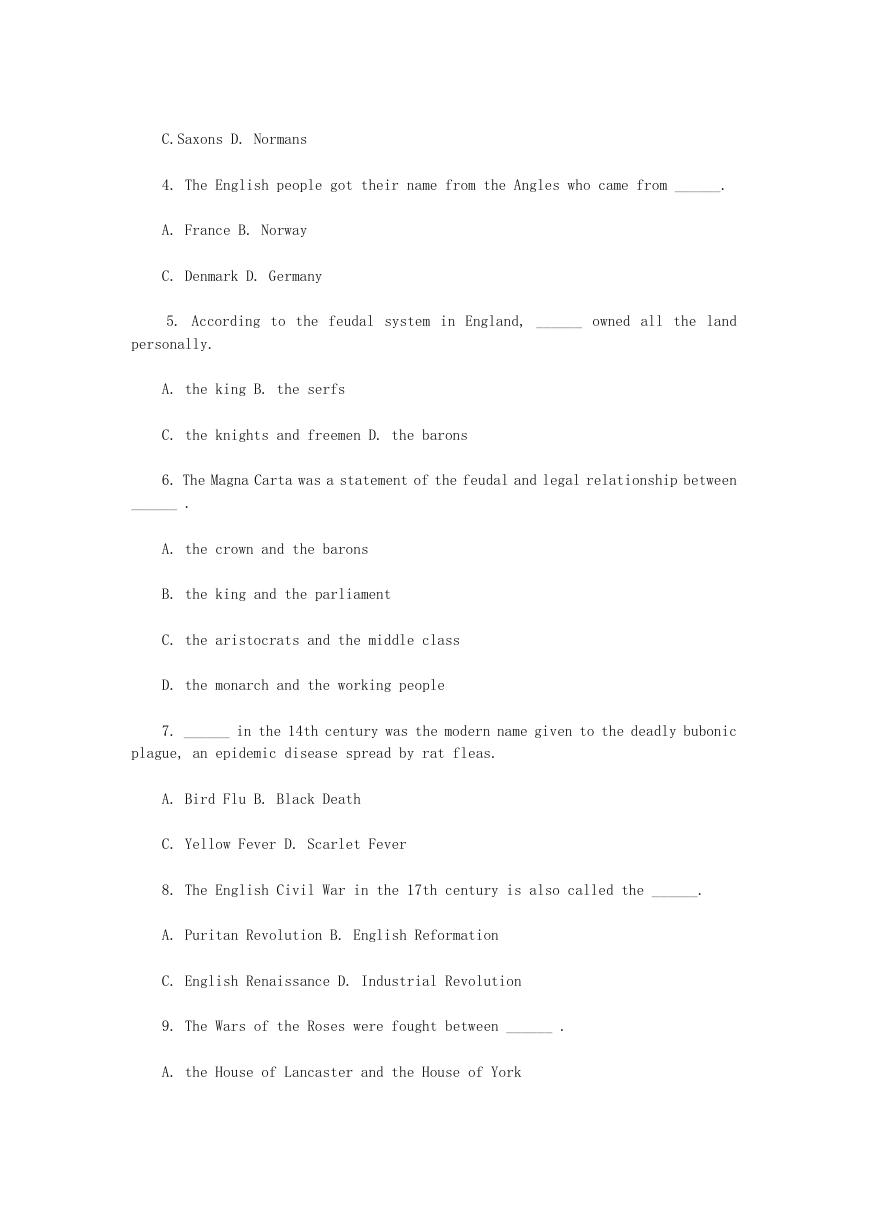
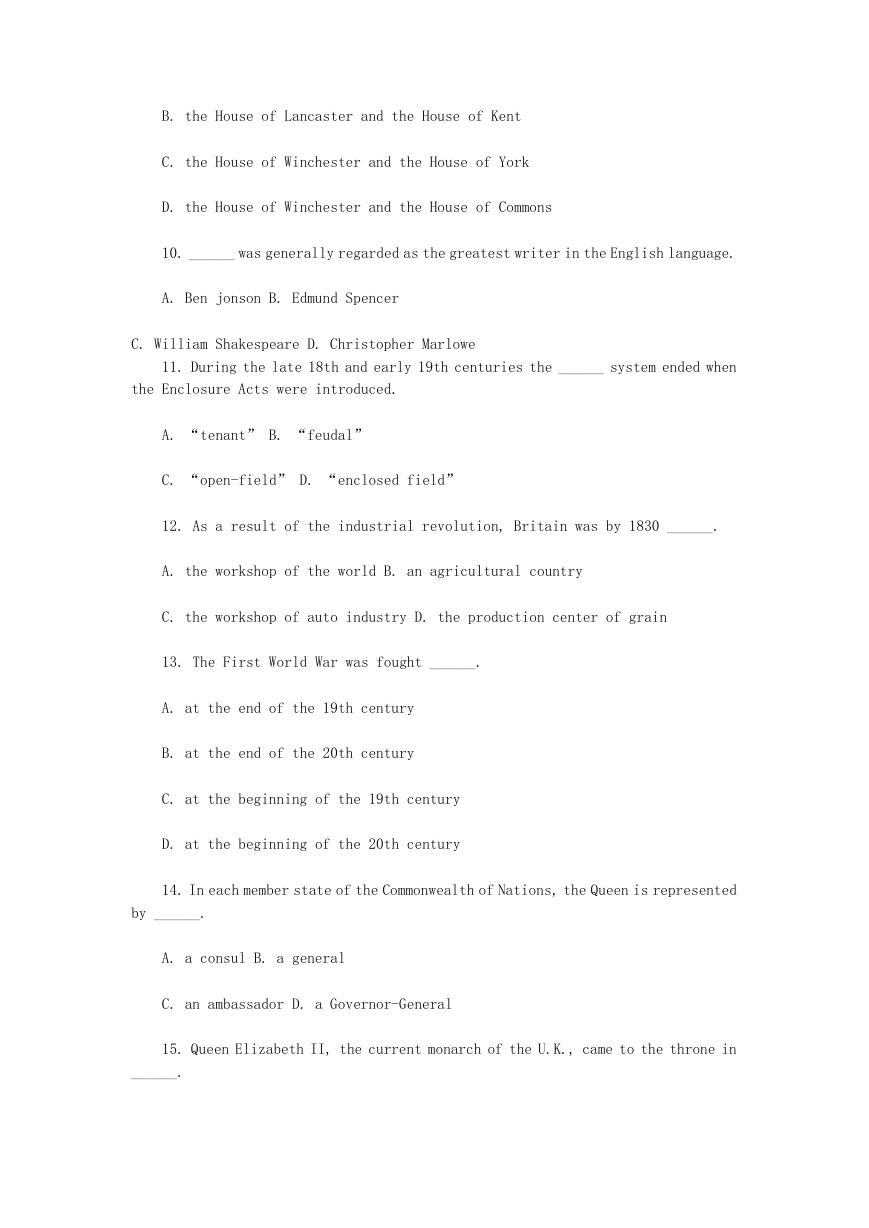
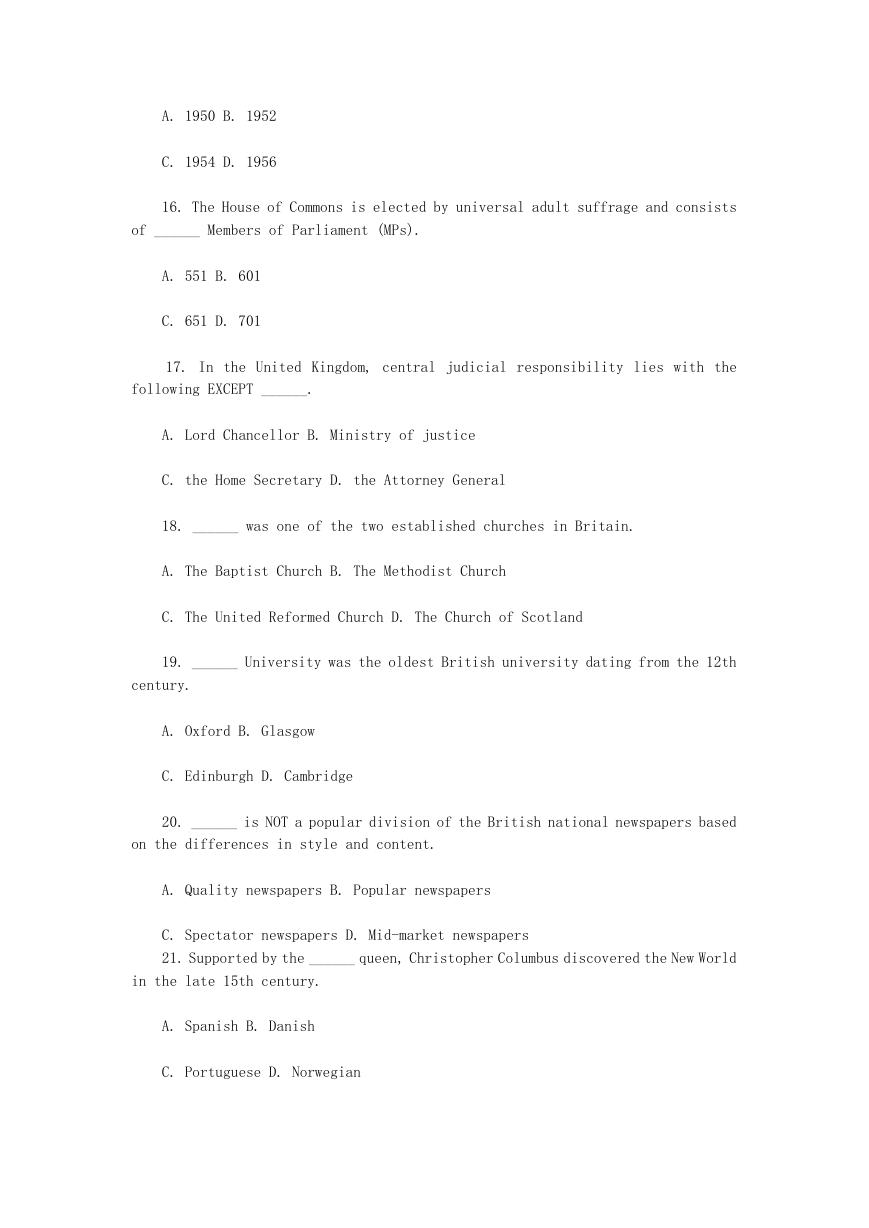
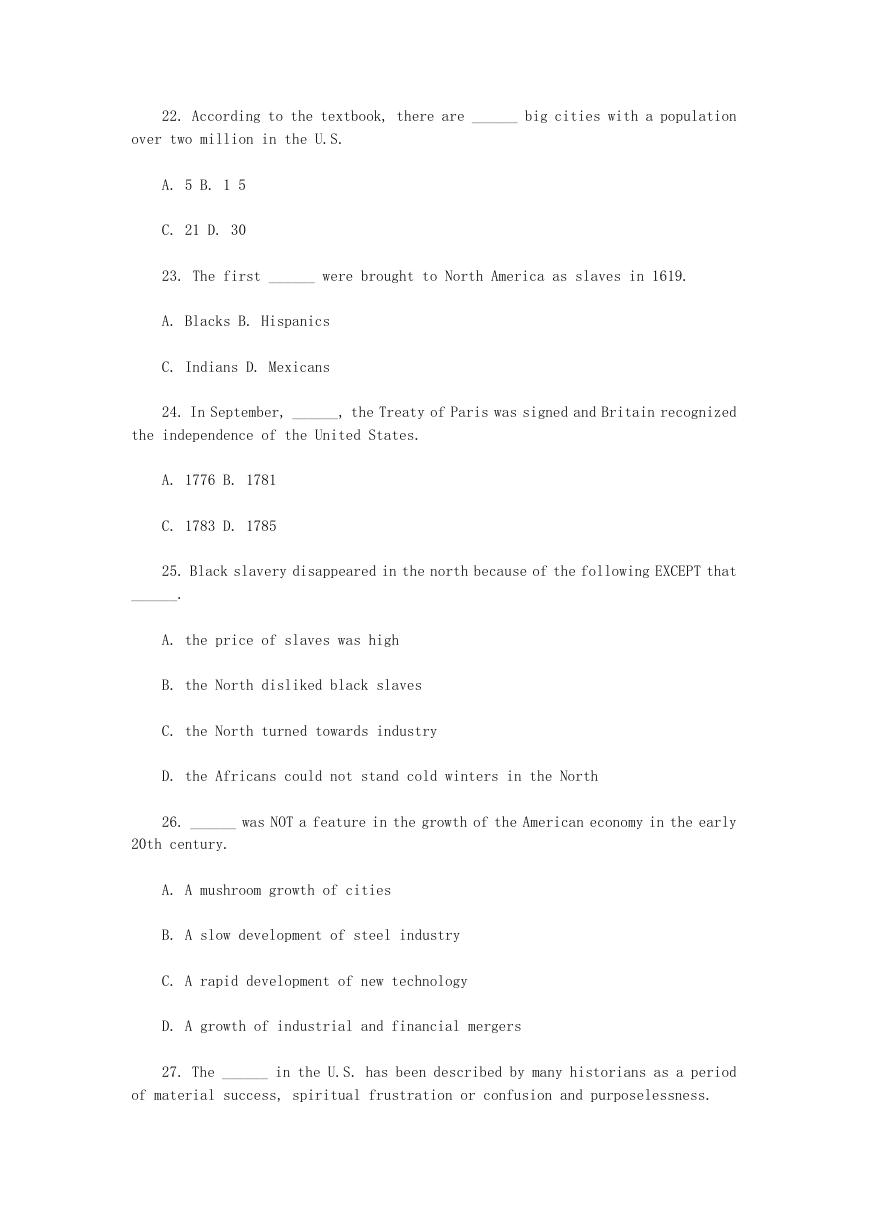
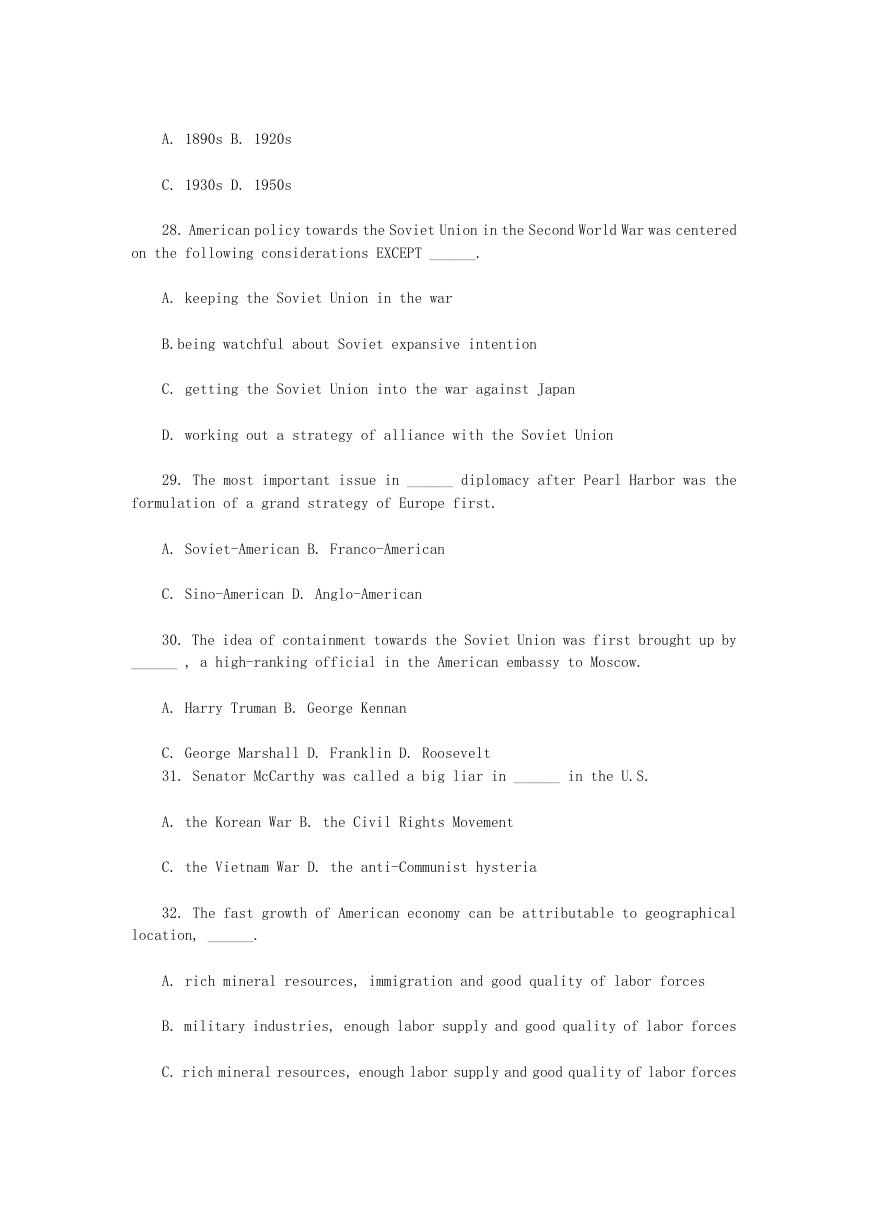

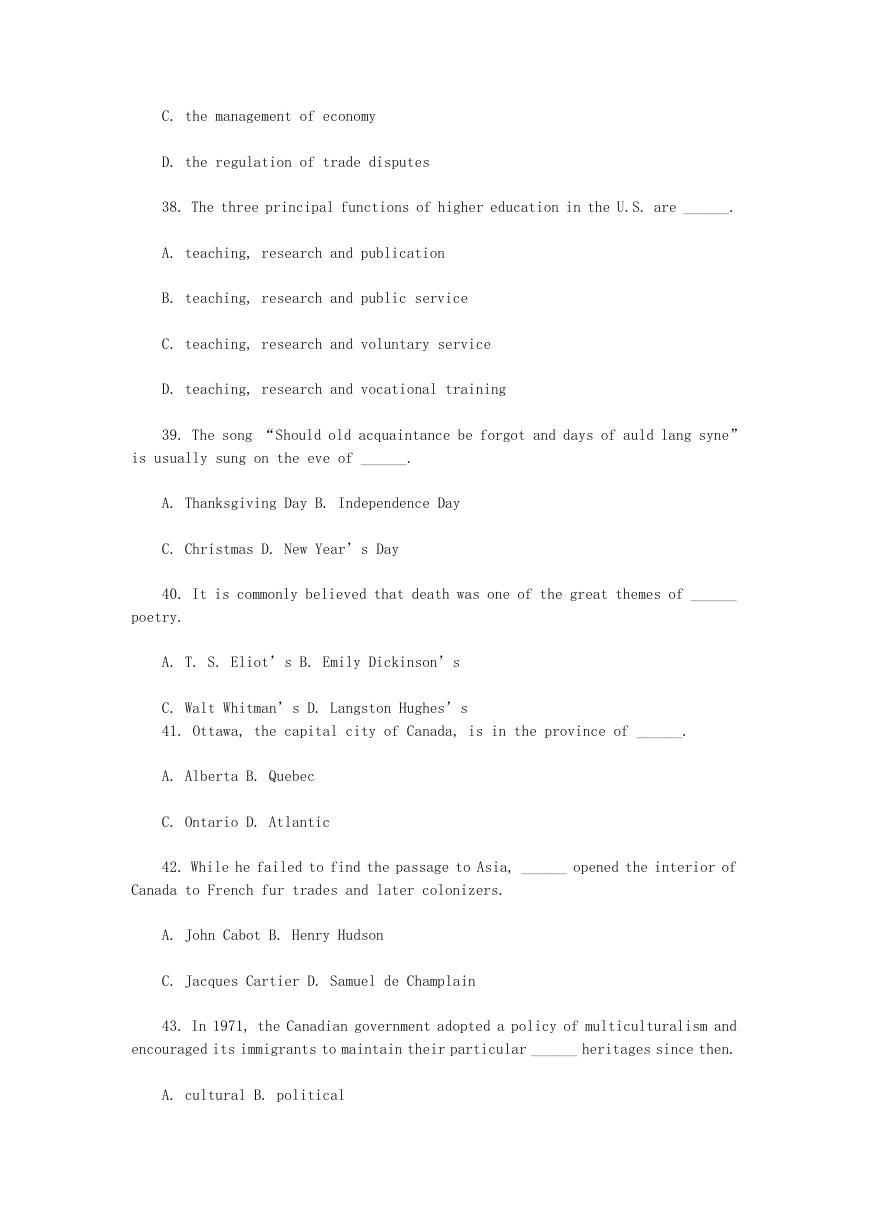








 2023年江西萍乡中考道德与法治真题及答案.doc
2023年江西萍乡中考道德与法治真题及答案.doc 2012年重庆南川中考生物真题及答案.doc
2012年重庆南川中考生物真题及答案.doc 2013年江西师范大学地理学综合及文艺理论基础考研真题.doc
2013年江西师范大学地理学综合及文艺理论基础考研真题.doc 2020年四川甘孜小升初语文真题及答案I卷.doc
2020年四川甘孜小升初语文真题及答案I卷.doc 2020年注册岩土工程师专业基础考试真题及答案.doc
2020年注册岩土工程师专业基础考试真题及答案.doc 2023-2024学年福建省厦门市九年级上学期数学月考试题及答案.doc
2023-2024学年福建省厦门市九年级上学期数学月考试题及答案.doc 2021-2022学年辽宁省沈阳市大东区九年级上学期语文期末试题及答案.doc
2021-2022学年辽宁省沈阳市大东区九年级上学期语文期末试题及答案.doc 2022-2023学年北京东城区初三第一学期物理期末试卷及答案.doc
2022-2023学年北京东城区初三第一学期物理期末试卷及答案.doc 2018上半年江西教师资格初中地理学科知识与教学能力真题及答案.doc
2018上半年江西教师资格初中地理学科知识与教学能力真题及答案.doc 2012年河北国家公务员申论考试真题及答案-省级.doc
2012年河北国家公务员申论考试真题及答案-省级.doc 2020-2021学年江苏省扬州市江都区邵樊片九年级上学期数学第一次质量检测试题及答案.doc
2020-2021学年江苏省扬州市江都区邵樊片九年级上学期数学第一次质量检测试题及答案.doc 2022下半年黑龙江教师资格证中学综合素质真题及答案.doc
2022下半年黑龙江教师资格证中学综合素质真题及答案.doc